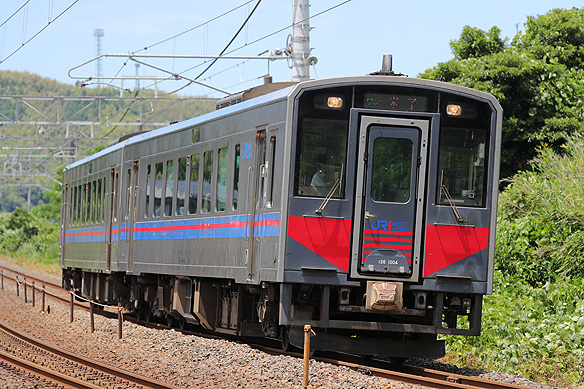Background and overview
JR West developed class kiha126 single-cab rural diesel multiple unit (DMU)
trains to reduce the journey time at completement due to carry out the
speeding-up work of San-in line between Yasugi and Masuda, where traffic
is decreasing year by year, and delivered five 2-car sets to Goto depot
in 2000.
Car body
They have 2800mm wide bodies with bead-less skin, incorporating light weight
stainless steel construction. The cab section and end structure are fitted
to their main body by bolts. Bodies are unpainted and have a blue and red
waistline band running the length of each car below the windows. The cab
section having a gangway is gabled and two plane windscreens having a cluster
of a rectangle-shaped sealed beam headlight and a rectangle-shaped LED
trail light behind them are fitted on both sides of the gangway door. The
front of the cab section is painted black with red narrow horizontal stripes
on the gangway door and red triangular accents below the windscreens. Anti-fall
plates between vehicles are also introduced excepting the cab end. The
side body structure features mirror symmetry for the skin parts standardization
to reduce the cost. They are equipped with two 1000mm wide stepped single
leaf automatic sliding doors which can be operated manually by pushing
the buttons fitted beside the door. They also have six 1100 mm wide double
glazed fixed windows and two 500mm wide windows between the doors, and
a 500mm wide drop window at the end. No hinged door for train crew is not
fitted at the cab. LED destination displays are fitted on each side of
the body. They are also equipped with an air conditioner, WAU707 rated
at 20,000kcal/h on the roof. A close contact coupler is employed.
Bogies
Powered bogies are WDT60 incorporating 2-axle drive, and trailer bogies
are WTR244, featuring bolster-less secondary air suspension, corn-shaped
multilayered rubber spring journal supporting system, and the single link
draw gear. Powered bogies employ the single tread brake rigging and trailer
bogies employ both the single tread brake rigging and the disk brake rigging.
Traction unit and ancillary equipments
They are powered by a four-cycle straight-six diesel prime mover, SA6D140-H-1,
with a power output of 450PS employing the turbo charger powered by the
flow of exhaust gas and the intercooler. Their hydraulic transmission gear
classified into DW21 features a three-member one-stage torque converter,
multi-plate wet clutch, and four-staged direct coupled range. A radiator
and heat exhaust fan unit are miniaturized to be fitted under the floor
to increase seating capacity. They aim to reduce manufacturing costs and
ease maintenance by standardizing equipments with JR West's EMU trains
in particular the 223 series by employing electrified and standardized
equipments to realize beltless. An engine driven generator, WDM111, is
powered by a prime mover via a Constant Speed unit supply three-phase 440V
to the air conditioner and the electric heating. This 440VAC is also stepped
down to 100VAC or rectified to 100VDC to supply to the control circuit
and the auxiliary equipments. A engine driven air compressor, WCW800, is
connected to a prime mover with gears. Class kiha126 vehicles adopt the
transmission control unit, TICS (Train Information Control System), which
runs on PLC (Programmable Logic Controller) to reduce trains lines and
relays. The brake system is changed into the electric command pneumatic
brake with jake braking. If the jake braking is no longer able to provide
the specified braking force, the pneumatic braking supplements it. All
vehicles are equipped with ATS-SW onboard signaling system beneath the
floor.
Accommodation
Seating is arranged as a mixture of longitudinal bench seating located
beside doors and transverse seating bays with 1600mm seating pitch. Trailer
end cars, Kuha415, have a Japanese style toilet. These cars are not air-conditioned.
The frame of the armrest and windows employ woody material to obtain warm
space. Prefabricated panels preassembled with the luggage rack and the
hand straps were employed. Straps were fitted throughout the passenger
saloon. A door chime is fitted in the door header of each sliding door.
Class kiha126-0 vehicles are equipped with a universal access style toilet
located behind the cab section. The ticket machine, which puts the ticket
indicating the boarding station, is located beside doorways at the end
of their body. The fare chart seven segment display and the fare box are
located behind the driver's cab. As for the device of driving the cab,
a two-handle master controller is adopted the same as EMU trains.
Operations
Class kiha126 vehicles entered the Sanin line "Aqua liner" rapid
services, and rural services between Yonago and Masuda in 2000. Five additional
two-car sets were delivered in 2003, and entered the Sanin line between
Toyooka and Yonago, the Hakubi line between Shoyama and Houki-Daisen, the
Inbi line between Tottori and Chizu, and the Sakai line to be used on "Tottori
liner" rapid services and rural services. "Aqua liner" rapid
services were discontinued in March 2022. They are now used on the Sanin
line between Toyooka and Masuda, the Hakubi line between Shoyama and Houki-Daisen,
the Inbi line between Tottori and Chizu, and the Sakai line. |
|

